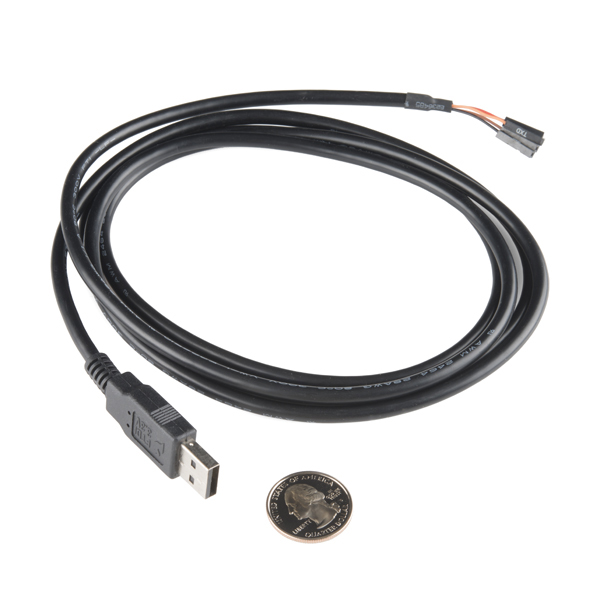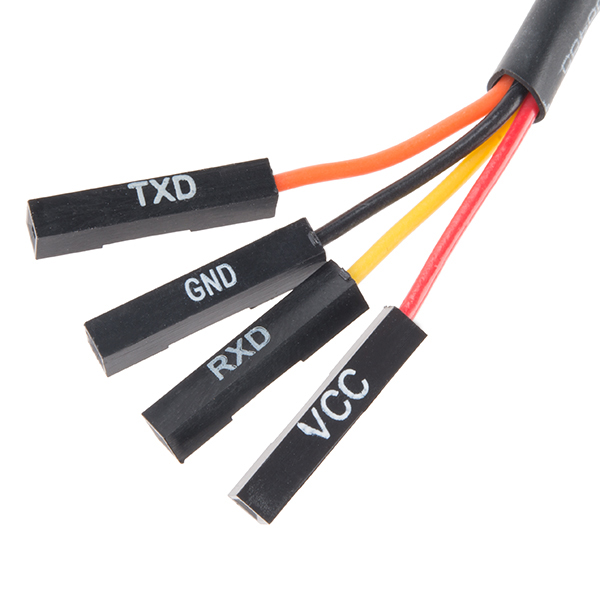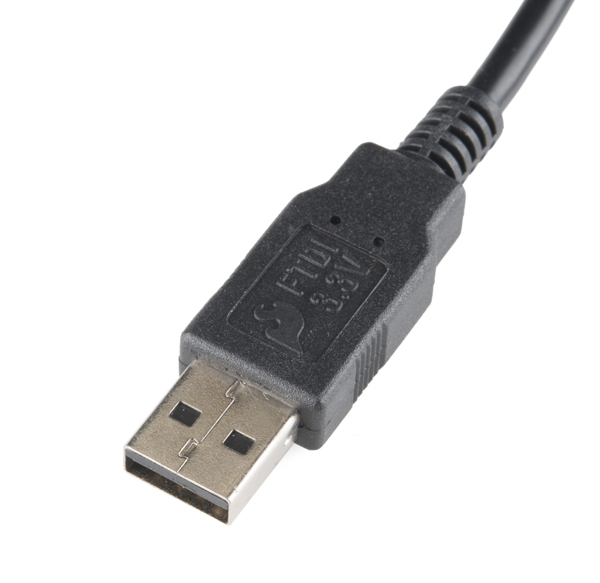This is a USB to TTL Serial Cable which allows for a simple way to connect TTL interface devices to USB. The I/O pins of this cable are configured to operate at 3.3V specifically with a Raspberry Pi with each serial pin broken apart. Thanks to its separated pins, this cable is a perfect candidate for powering, connecting, and accessing the login and debug console on the Raspberry Pi.
The FTDI cable is designed around an FT232, which is housed in a USB-A connector. The other side of the cable is terminated with a separated 4-pin connector with the following pinout: RX (Yellow), TX (Orange), VCC (3.3V) (Red), and GND (Black). A link to the FTDI drivers can be found in the Documents section below.
Comments
Looking for answers to technical questions?
We welcome your comments and suggestions below. However, if you are looking for solutions to technical questions please see our Technical Assistance page.
Customer Reviews
4.4 out of 5
Based on 30 ratings:
1 of 1 found this helpful:
Works well, but I missed the part about 5V
This product works well, but I thought it was regulating the USB 5V down to 3.3V. I realize now that I didn't read closely enough.
Works great as a Raspberry Pi console connector
I bought this to connect to my Raspberry Pi console. After a little experimentation, it worked fine (connect Tx to Rx; not Tx to Tx).
I found it reliable and easy to connect.
Good, Solid Cable
Performs right out of the box, good driver support from the manufacturer!
Best thing I ever owned!
And here's why ...
needed an out-of-the-box solution for communicating with the UART on an Atmel XMEGA eval board.
This thing was plug in and go.
no fuss, no muss.
Worked great
What else can I say?
great cable easy usage
This cable is a great price and great value. I used it to build a usb programming cradle for fire dept Motorola minitor 3 and 4 pagers. Works flawlessly after updating the drivers from the product page. The shipping was fast and packing was super.
Reliable USB-Serial cable assembly
Very happy with the purchase! The cable assembly is very reliable and we have had no issues!
0 of 2 found this helpful:
Great product
I hate ftdi i feel dirty for buying a product from them. I wish they used a cp2012 or anything else but evil ftdi.
Essential for any toolbox
Buy three, you know you'll need them.
No complains yet
It's doing what was supposed to do, the connection from place A to B.
Newbie getting started commucating with Android smart phone to RN-52 module
Works like advertised
Super easy to wire to test headers. Price is unbeatable
Great diagnostic tool to replace RS-232. (3.3V levels compatible with most modern MCUs / FPGAs)
WARNING! Check wire color & labels!
The cable I received was labelled wrong! The TXD and VCC were swapped. They should have been: TXD = Orange wire, RXD = Yellow wire, VCC = Red wire, GND = Black wire. I swapped the housings (easy to do - lift the plastic tab and slide contacts out) and now it works properly. I rated it low because of poor manufacturing quality control, and my time wasted debugging the problem.
Does exactly what it's supposed to
I bought this specifically for a Raspberry Pi because the description specifically mentions that. I was hoping it would come with connection directions, but I had to figure that out on my own.
Also, I discovered that this cable will power the Pi when plugged into my laptop.
It just works.
I have half a dozen of these. They just work.
Works very well, as advertised
Plugs directly into my 3.3v PIC uart i/o for debugging.
Works at high speed
Works well. The FTDI chip supports high speed and non-standard baud rates. I tested it up to 500 kbps.
The RX and TX headers are labelled from the frame of reference of the target (not typical). So connect Tx to Tx and Rx to Rx.
Update: I purchased more of these and the RX and TX have been swapped again. The inconsistency is no bueno. You will need to check which wire is actually TX on the scope before plugging these in.
Director
Great product, just wish it was a bit cheaper.
Immensely handy, must have tool.
I use these so often. Many many embedded boards come with the 4-pin serial populated. The VCC doesn't need to be connected but the tx/rx/gnd can be connected any which way and then it's just a matter of determining baud rate. The Raspberry-Pi especially is perfect for this cable. ASUS, and other, Wi-Fi routers all have the 4-pin serial header. This cable is absolutely the most handy tool in my toolbox.
Fast & Awesome
fast shipping the correct part awesome job !!
Works perfectly
No problems getting this to work. Windows 10 recognized it immediately and assigned it to COM3, which is exactly what I wanted.
Cable received says 3.3V on the USB plug, BUT VCC IS AT 5V!! Measure before you blow up your devices...
Cable is well made with nicely labelled breakouts, but after struggling to connect to my ESP8266 for an hour, thinking I was doing something wrong, after noticing the ESP getting incredibly hot, I measured the output of the cable and it was at 5V from VCC to GND. I'd expect something this dumb to not happen when ordering from Sparkfun. Yikes!!! Also, the link to the drivers page doesn't take you directly to the right place, but I used the VCP drivers found here: https://www.ftdichip.com/Drivers/VCP.htm the executable makes installation super easy.
Received mine and it had the yellow and orange wires both labeled with RXD. Since there was confusion in the other reviews I decided to check everything with my voltmeter and logic analyzer. The orange wire marked as RXD was indeed the TX (i.e. characters sent out from my PC). The VCC was 3.3V as advertised and matches what is on the USB connector.
In general I'm happy with this purchase, but it seems like there are still a few quality control kinks to work out. Given the other reviews and my own experience, I recommend folks double check the labeling and voltages before hooking this up to something.
Excellent FTDI cable
Of all FTDI cables I have tried these are the best. That is why I waited months until they were back in stock again and bought several of them. I did not need to install a driver, As the description says the interface is 3.3V. The 4-pin connectors slide over posts. All very convenient and quality product.
Finally able to connect my android to my computer
I’m happy with this product. I was able to splice the wires and then connect it to my breakout board, and then to my computer. Thanks for having this product available!




The product description seems to be incorrect:
the VCC (Red) is 5V (NOT 3.3V)! Tx & Rx appear to be 3.3V
Hello! Is the 3.3v RX pin 5V tolerant? thanks,
I just received some of these and did find out that the VCC pin is connected direct to the USB connector, so it outputs 5V.
This should be mentioned in the description. I don't know why it isn't.
How long is it? For the other FTDI cables that info is in the schematic (where it doesn't belong), but no schematic here. 1.80m?
Will this work for connecting the Serial LCD kit (LCD-10097) to my computer, i.e. does that kit accept 3.3V on the data line just fine?
Nice! This is almost as cheap as buying an old CA-42 Nokia data cable from eBay and replacing the connector, but a lot less hassle!
VCC is 3.3VDC at ?? ma ~= 500ma I would guess but no document so wanted to ask.
My experience with similar FTDI cables is that while the I/O is at 3.3V levels, the VCC pin would be 5V coming directly from the USB socket. But verification from someone in the know would be good....
This cable lacks the DTR signal which is needed if you intend to connect to a microprocessor whose bootloader is triggered by DTR, as are Arduino and others.
No DTR fore resetting Arduinos?
Nope. We do have FTDI cables and FTDI boards that do, you can also just manually hit the reset button. This cable is specifically for communicating over serial with things like a Raspberry Pi, PCDuino, etc.
The Raspberry Pi uses 3.3 V logic on its GPIO and com port lines. FTDI makes both 5V and 3.3V cables like this, so whzt you are supplying may be the correct 3.3V one. But your description states otherwise i.e. it mentions 5v IO.
I was thinking the same thing. I bet it is just an error in the text. In the photos, the USB connector shell is labeled "FTDI 3.3V"
Totes. Was just an error. Thanks!